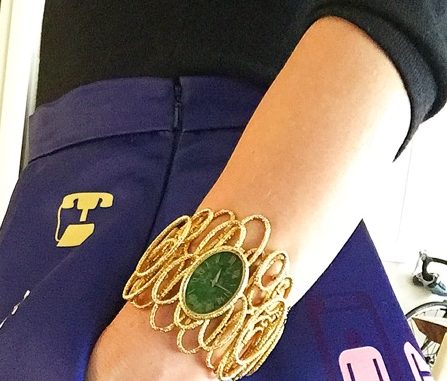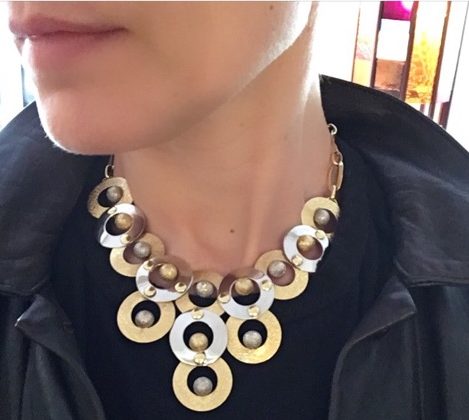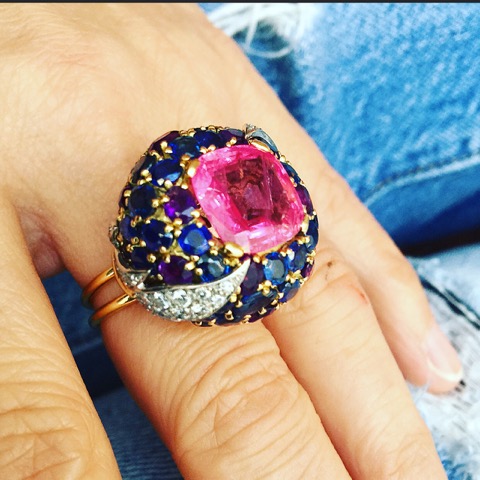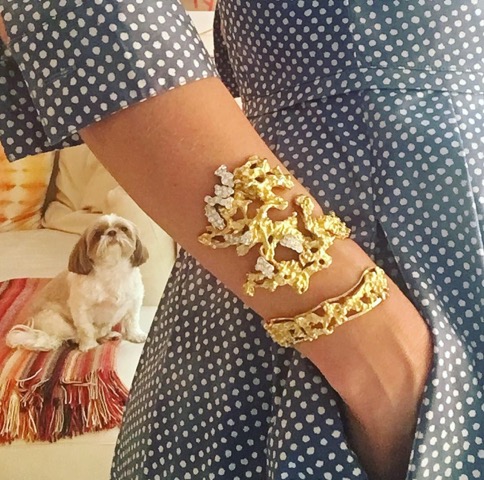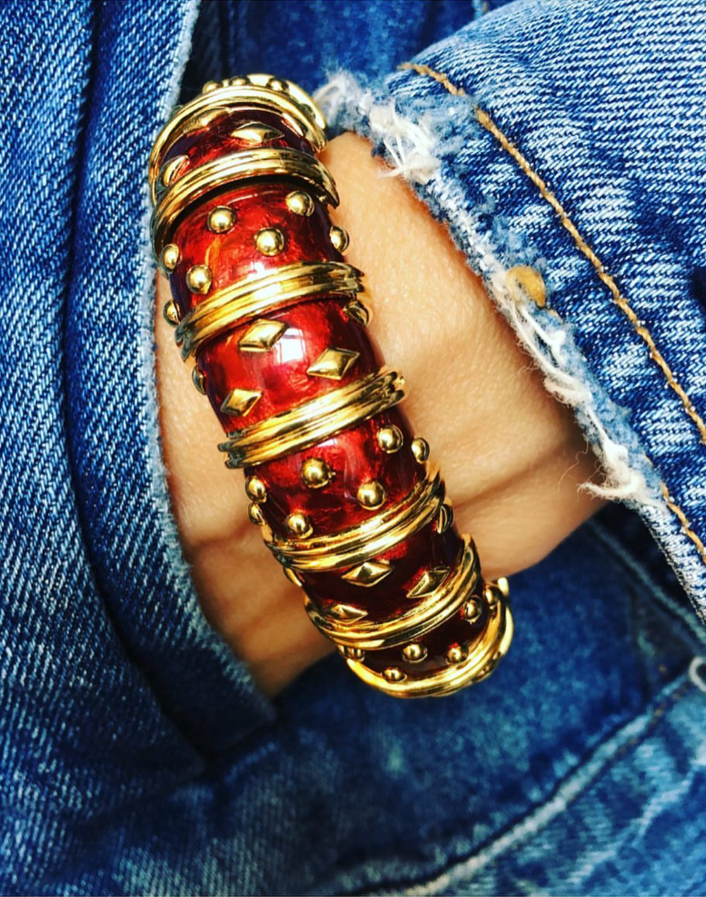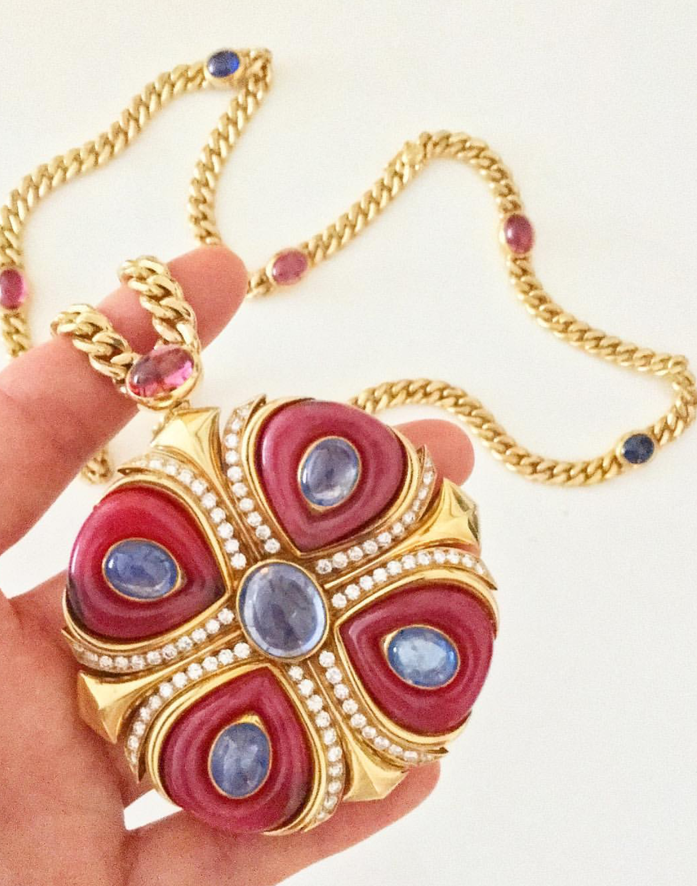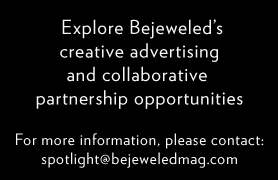Robin Katz Vintage Jewels: A Revival of Style
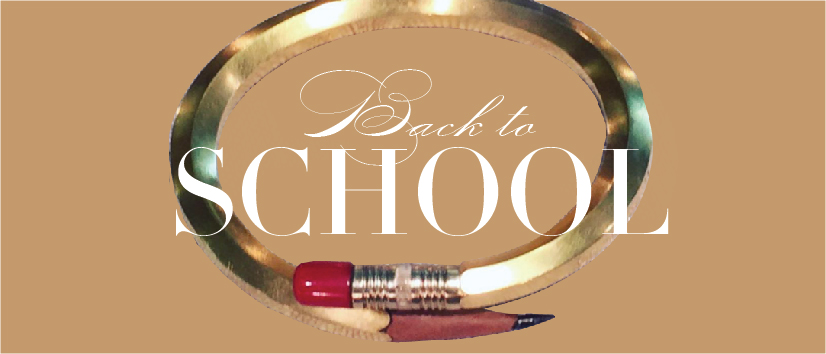
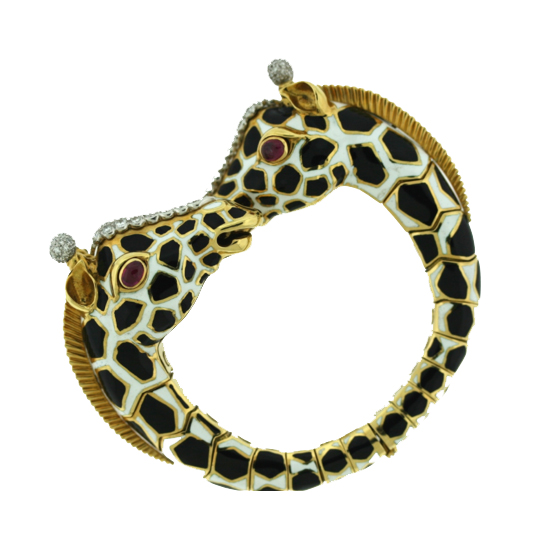
David Webb 18k gold and platinum, iconic, double-headed giraffe enamel bangle bracelet.
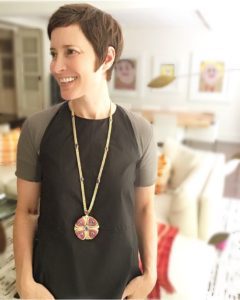
Robin wearing a Bulgari necklace, circa 1970s
The first time I took a peek in Robin Katz’s jewelry display case at a trade show, my youth passed before my eyes. Although I collect and am vastly more knowledgable about 17th-19th century jewels, these vintage pieces from the 1960s through ‘70s I knew intimately and grew up surrounded by. Didn’t my grandmother own a David Webb cuff similar to the one sitting on top of a velvet pad? A pendant that Robin was wearing with a patchwork suede jacket and jeans looked so similar to a long pendant my mom wore with her own suede jacket and Klute-style shag.
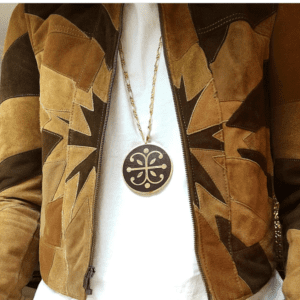
Robin wearing a Van Cleef & Arpels wood and gold necklace, circa 1970s
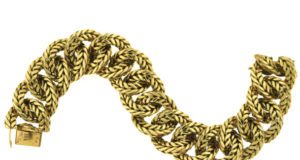
Van Cleef & Arpels 18k gold bracelet of interlocking woven links., circa 1970s
Chunky curb link-bracelets and bold buckle style from Gucci and Hermes like those my mother’s friends wore drew me further into Robin’s selection. From grade school through high school, similar jewels sat on top of dresser and vanities of the maternal side of my family.
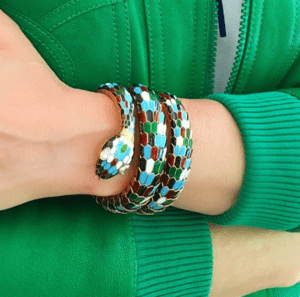
Bulgari Serpentini polychromatic enamel bracelet watch with diamond eyes and Jaeger LeCoultre movement, circa 1960s
Robin’s pieces are cool, representative of rebellion, free love, women’s lib, banning the war and burning bras. It was also a time of anything goes and trying out something new, of wild creativity in style and a bold use of color that appealed to the swinging London in the ‘60s and the more pulled-together socialites of Palm Beach in the ‘70s. Renowned houses such as David Webb, Van Cleef & Arpels, Cartier and a host of other jewelers kept up with the changing times and appealed to the youth culture with their ethnic influences and design details that spoke to the movement of the day .
And, Robin Katz has a ‘groovy kind of love’ for pieces of the decade, which is how she has developed an eye for some of the most exceptional, rare, whimsical and imaginative pieces of the time periods of which she specializes. The Vintage Jewelry collection she has cultivated is always on point, balanced, impeccably edited and distinctively curated.
- iaget 18k textured gold bracelet watch with nephrite face, circa 1970s
- 18k yellow and white gold necklace of a mod design of articulated overlapping links, circa 1970s
In addition to Robin’s knowledge, her passion for what she finds and what she is selling creates an inviting atmosphere to ask questions. She possesses an effervescent, warm disposition when welcoming you to view her jewels.
The perfect model for her vintage pieces, Robin projects confidence and the style savvy to balance the fashion and jewelry from the past so that they express a modern sensibility. I had the pleasure of speaking to Robin about her entry into the business and how a woman can reflect her individual take on wearing jewelry from this time period. I also asked her to share a few pointers on how to start building a collection of pieces from ‘60s through late ‘70s.
- Schlumberger 18k gold and platinum ring of bombe design centering a pink sapphire with a surround of sapphires and amethysts with ribbons of diamonds, circa 1960s
- 18k gold and diamond wrap cuff of abstract naturalistic design, circa 1970s
How early did your interest in jewelry begin?
“When I was about 8 I began ‘borrowing’ pieces from my mother’s jewelry box. Unfortunately for Mom I borrowed more than I returned.”
How did you get involved in the business of jewelry?
“My first job as a 15 year old in Poughkeepsie, NY was for Zimmer Brothers Jewelers, where I began on the wrapping desk and graduated to salesperson over the next five years through high school, summers and college vacations.”
How did you start out as a collector or dealer?
“I have always been and still am a collector. When I first laid eyes on a piece of vintage jewelry, David Webb in fact, I had an epiphany. Literally. From that moment on I have been a 1960-‘70s devotee as both a collector and a dealer.”
Does that mean you only deal in Vintage ‘60s through ‘70s jewelry?
“Although I am drawn to stylish pieces across all periods I chose to specialize in the 1960s and ‘70s as these are the pieces that speak to my soul. During these decades, I’ve found the perfect balance of glamour and design. It’s that combination for me that makes a piece desirable and compelling.”
What was the first piece you ever bought to sell?
“I never really buy anything specifically to sell. Don’t get me wrong, I am in business to sell, but I never buy anything I wouldn’t want to personally own. I ask myself if the piece doesn’t sell, would I be happy owning it. If the answer is yes it’s a go. That is why my collection is cohesive and tightly edited…. I only buy what I love.”
Have there been pieces that passed through your hands that you wished you hadn’t sold?
“There was an incredible and rare Van Cleef & Arpels suite of a 1970s coral, onyx and diamond sautoir, bracelet and earrings. It was magnificent and something I will likely never come across again. Years ago, there was more of an abundance of those types of spectacularly designed pieces than there is today. Had I realized how difficult it would become to find these jewels and their commensurate escalation in price I would have held onto it without hesitation.”
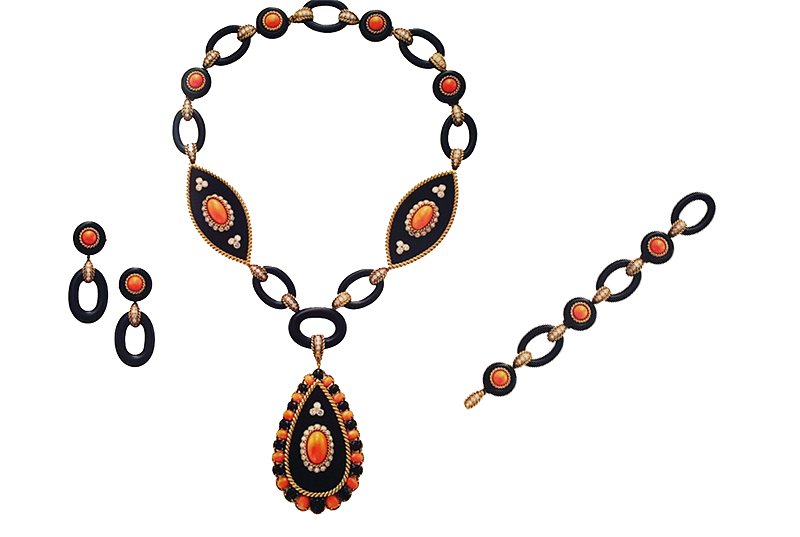
Van Cleef & Arpels 18k gold onyx, coral and diamond suite, circa 1974.
Where do you sell and how do you sell?
“I have a private office where I meet with clients on an appointment only basis. I also exhibit at one or two shows each year, usually at the New York and Miami fairs.”
What are some of your favorite pieces in your collections and why are they the ones you cherish most?
“There is a fluid movement of pieces between my personal collection and my inventory. There are very few pieces that I would never sell. Those that have been lovingly given to me are most precious as are those that are symbolic of certain occasions or milestones. The vast majority of pieces are disposable, although I wear and have great appreciation for them.”
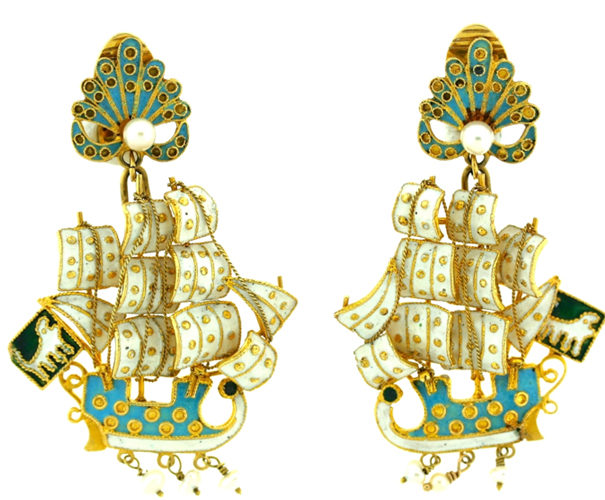
18k gold enamel and pearl earrings of a sailing ship motif, circa 1960s
What was the most famous piece you every owned or your favorite piece with a story behind it that you sold?
“True stories are hard to come by in the estate jewelry arena. Most pieces, unless they are purchased directly from the owner, do not come with any stories at all. It’s sad in a way because every piece does have a past. It may not have been pretty or exciting but it was there. As pieces pass through various owners’ hands those stories are lost, most never to be recovered. I love to view the auctions of important jewelry collectors to see photos of the person wearing their jewels at specific occasions and with specially chosen outfits. Daisy Fellowes, Elizabeth Taylor, Marjorie Merriweather Post, Lily Safra and The Duchess of Windsor all had extraordinary collections and wore their jewelry with such pride and style. A picture is worth a thousand words.”
Talk a little about what you think women/collectors want today.
“Wearability is high on the list. Most of my clients are not interested in collecting jewels that are so precious or fragile they cannot frequently be worn and enjoyed. I understand this sentiment completely and feel the same way myself, which is why many of the 1960s and ‘70s pieces are so practical. They are stylish and glamorous but not so over-the-top that they cannot be utilized in a woman’s everyday life. Few women are interested in keeping their jewelry in the safe deposit box anymore. Women occupy an ever-increasing presence in the workforce and are able to purchase jewelry for themselves on their own terms. Generally speaking they are looking for jewelry that reflects their personalities and lifestyle. And they are looking for value. The more times they can wear a piece of jewelry the more sense that purchase makes.”
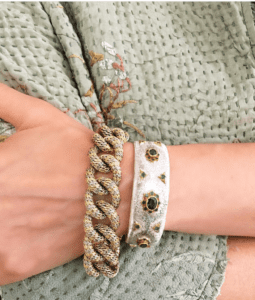
Van Cleef and Arpels woven link bracelet described above worn with Buccellati bracelet
Do you have any advice for women interested in collecting pieces from this time period?
“It all depends on why one is collecting but I would say listen to your heart. Often your first reaction is truest and most telling. Rational thinking tends to kick in secondarily and can really muddy the waters.”
“Think about your collection as a whole. Try to purchase pieces that increase the wearability of other pieces you already own. For example choose styles that work and complete each other in layering and textural interest. In addition, think of special clothing that requires a certain type of jewel to compliment it. Personally I think about all of this and try to maintain a well-rounded collection.”
“Balance is also important to any jewelry collection. Try to incorporate pieces that are bold and others that are more delicate. Also add colorful styles to those more basic and versatile.”
“I also try to find pieces that are unique. This is important to me. The jewelry, clothing and accessories I choose to decorate myself with are a reflection of my style and mood. I like to communicate and project my individuality through these choices and I like to make different choices each day. This is probably why I borrowed more than I returned of my mother’s jewels and also why I probably began collecting in the first place.”
- Schlumberger Paris 18k gold Dot Losanges articulated bangle bracelet with candy apple red enamel. Made in France.
- Bulgari Necklace, circa 1970s

